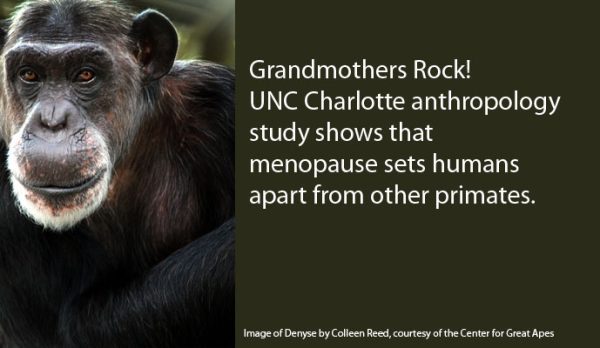Distinctiveness of Human Reproductive Aging: Grandmothers Rock!

A study by a UNC Charlotte researcher and colleagues of mortality and fertility patterns among seven species of wild apes and monkeys and their relatives, compared with similar data from hunter-gatherer humans, shows that menopause sets humans apart from other primates.
Nonhuman primates aren’t immune to the fading female fertility–reproductive senescence–that comes with age, the researchers say. But human females are unique in living well beyond their childbearing years.
In a study which appeared the week of July 29 in the Proceedings of the National Academy of Sciences, anthropology faculty member Diane K. Brockman of the University of North Carolina at Charlotte and colleagues compared mortality and fertility data for seven species of wild primates to similar data for the !Kung people of Southern Africa, a human population of hunter-gatherers with limited access to modern medicine or birth control. The nonhuman primate data were based on long-term observations of 700 adult females, including sifaka (a lemur) in Madagascar, capuchins in Costa Rica, muriqui monkeys in Brazil, baboons and blue monkeys in Kenya, chimpanzees in Tanzania, and gorillas in Rwanda. This is the first study to compare humans with multiple primate species living in the wild.
For each species, the primate biologists estimated the pace of reproductive decline — measured as the probability, at each age, that a female’s offspring will be her last — and compared it with the rate of decline in overall health, measured as the odds of dying with each passing birthday. This allowed the researchers to compare the rate of aging in the reproductive system with the rate of aging in the rest of the body (e.g. somatic senescence).
The results suggest that in nonhuman primates, reproductive decline is surpassed by declines in survival, so that very few females fail to reproduce before they die. A female sifaka, for example, can live to 24 years of age, and she continues to reproduce to the end of her life. The reproductive system of human females, on the other hand, shuts down much more rapidly than the rest of the body. The average age of menopause in the U.S. is 51 years, and fertility starts to decline about two decades before that, accelerating rapidly after 37 years, reports Brockman.
What distinguishes a human female from her primate cousins is not that the human biological clock ticks faster, but that mortality is so much lower in humans than in other primates, according to work done by University of Utah anthropologist Kristen Hawkes, who was not an author of this study. This study provides strong support for that idea. In both humans and chimpanzees, for example, female fertility starts to decline in the late 30s and early 40s, but most human females without access to modern medicine like the !Kung survive for several decades after their last child is born.
Humans have obviously evolved longer lifespans than our primate cousins, so why hasn’t female reproduction kept pace? And in a world where individuals with more offspring tend to win the evolutionary contest, why terminate reproduction with decades of survival still ahead? One idea is that older females who forego future reproduction to invest in the survival of their existing children and grandchildren gain a greater evolutionary edge than those who continue to reproduce. Once an infant primate is weaned it can forage for itself, whereas human infants continue to be nutritionally dependent long after they leave the breast, and grandmothers can be instrumental in ensuring the survival of their grandoffspring.
Alternatively, it can also be because the numbers of mammalian eggs are finite. According to this idea, we’ve extended our lives to the point where we’ve outlived our egg supply. A woman is born with a lifetime supply of 1-2 million oocytes which steadily decline with age thereafter — in contrast to sperm, which men produce throughout their lives.
Few data exist on fertility rates in natural populations of long-lived mammals, but recent studies of female killer whales experience reproductive senescence at a faster pace than general senescence, and like humans cease to reproduce by age 50 and thus exhibit an extended postreproductive life. Female African elephants, on the other hand, continue to give birth to infants well into their 50s and occasionally into their 60s, suggesting that at least one mammal species appears to have surpassed the typical lifespan for mammalian eggs. The paucity of data on other long-lived mammals is insufficient to test the oocyte shelf-life hypothesis. Nevertheless, the divergent findings of these two species suggests that the pacing of reproductive senescence relative to somatic senescence can vary substantially across long-lived species.
Journal Reference:
1. Susan C. Alberts, Jeanne Altmann, Diane K. Brockman, Marina Cords, Linda M. Fedigan, Anne Pusey, Tara S. Stoinski, Karen B. Strier, William F. Morris, and Anne M. Bronikowski. Reproductive aging patterns in primates reveal that humans are distinct. PNAS, July 29, 2013 DOI: 10.1073/pnas.1311857110
Adapted from Duke University Medical Center (2013, July 29). Hot flashes? Thank evolution. ScienceDaily. Retrieved August 15, 2013, from http://www.sciencedaily.com¬ /releases/2013/07/130729161948.htm